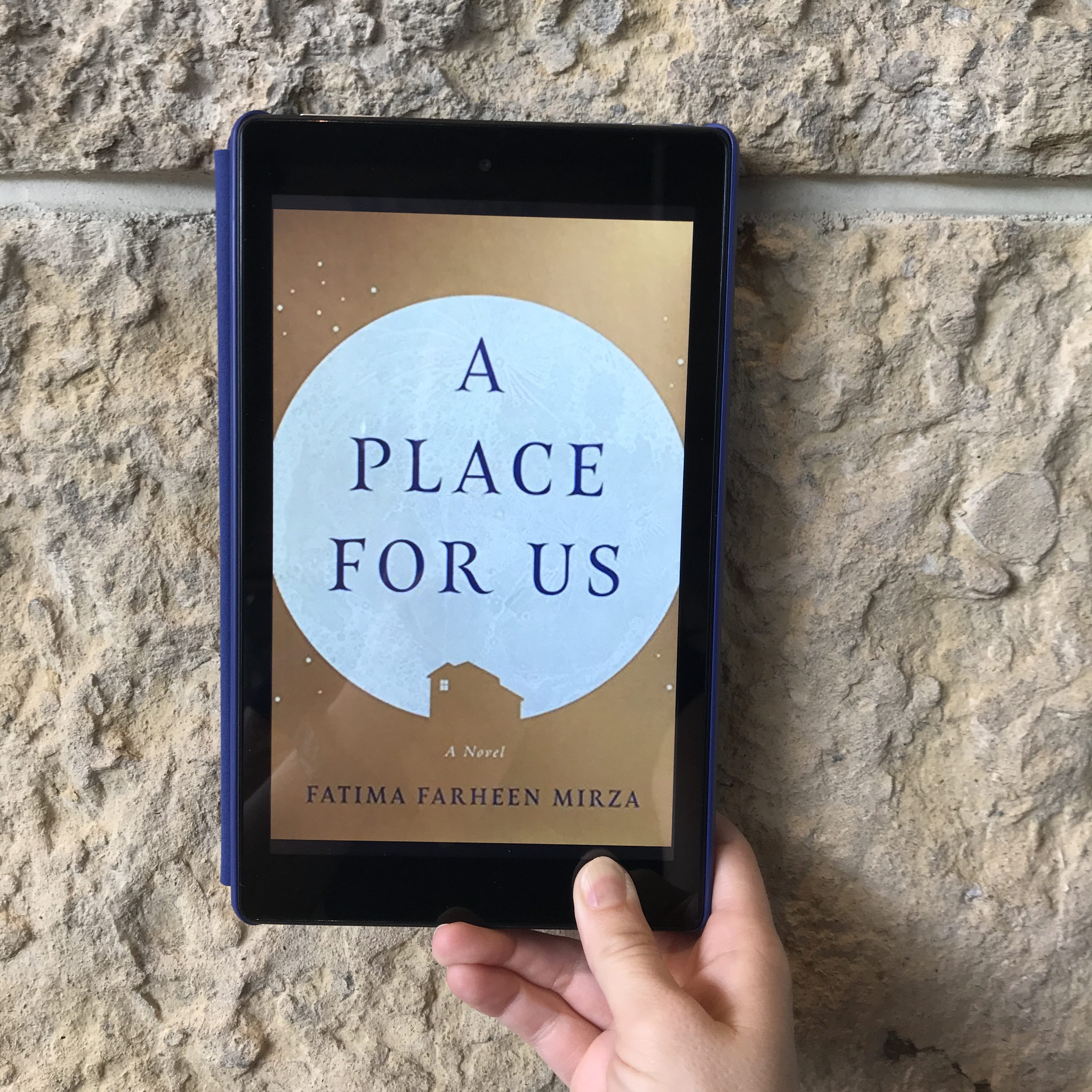Note: I drafted this post before the decision issued yesterday in Trump v. Hawaii upholding the Muslim ban. I enjoyed A Place For Us and felt it was relevant when I finished it almost a month ago–today it feels even more relevant. No matter what the president and the courts have said, Muslims have a place in this country. This is our generation’s Korematsu and I hope that we feel shame over it sooner rather than later. If you are of the Muslim faith or from an immigrant family and have stumbled upon this blog, hear me say clearly that you are wanted here. <3

I received a digital ARC of this book from SJP for Hogarth on NetGalley. I’m grateful to SJP for Hogarth for their generosity and am happy to post this honest review. All opinions are my own.
And it is in these moments that the fabric of my life reveals itself to be an illusion: thinking that I am free, we all are, that we could grow around your loss like a tree that bends around a barrier or wound. That I do not need to see you again. That the reality of our life as it is now is the best that we could have done and the best we could have hoped for.
Synopsis
Set on the day of an oldest sister’s wedding, A Place For Us, introduces the reader to a Muslim Indian-American family whose estranged youngest son has returned for the celebration. Though A Place For Us, Mirza explores themes of one’s place within a family, a family’s place within a community, and a Muslim and Indian community’s place within 21st Century American society. Told in shifting narratives through the decades leading to the wedding, A Place For Us shines as a deeply relevant, debut novel.
Structure
A Place for Us bounces around in time, which will drive some readers a little crazy, though Mirza writes within this structure as well as it can be done. The modern starting point is older sister Hadia’s wedding, for which Amar has come home for the first time in years. We’re told he’s been gone; from there the book flashes back in time to show us why and what it took for him to come home today. There is no date headers/signpost when the timeline changes—the narrative simply shifts and you determine through what people are talking about how many years forward or backward you are within the children’s lives. This could be really confusing, but in Mirza’s hands, it’s as clean and clear as it can be. She has major events in the children’s lives as signposts that come up fairly quickly. These events and/or comments about the children’s ages or school grade are peppered in early within new sections so you can quickly place it within the narrative.
This has the effect of making the narrative read like a puzzle—you can pretty clearly understand the piece in your own hand and with a little study, you can see where it goes. Each piece makes you form one idea as you read and that idea is confirmed or changed when another character’s point of view and experience appear several vignettes later.
The other thing that helps this structure be less jarring is that the book is told in third person by an omniscient narrator so you can tell when the perspective shifts to another character and who that person is. Several perspectives and times appear within most chapters so when Mirza shifts time and person, there is a paragraph break and symbol that indicates a change so you know you need to be looking for a different time and character. I enjoy when authors use non-linear timelines; just be warned this structure (in addition to the themes and content) make this book one that does require a little more energy and focus to really dig into.
Character Development
The bouncing in time reveals different characters to varying extents. The early chapters are heavy on Hadia and Layla, the three children’s mother. The center picks up more with Amar and the ending is almost entirely Rafiq, the father.
At its heart, A Place For Us is about Amar’s place within the family as much as it is about the place of an Indian Muslim family in modern American society. It is interesting then that Hadia and Layla are the ones to introduce us to Amar and Rafiq—these two women largely form our opinions of the boy and his father before either of them is allowed to influence our feelings of them much.
Hadia comes across in her own vignettes and others as mostly likeable. She isn’t perfect—she makes (but recognizes) her mistakes. She is perhaps the only character whose presentation didn’t change how I felt about her through the book. Layla’s early chapters make her seem sympathetic; yet later chapters made me reform my opinion. In her efforts to do the best for her children, she does things that hurt them, never really realizing her role in creating the current system of estrangement we have now. You don’t see her mistakes until after you’ve met and been hearing from her for a while, though, so the shift felt like a betrayal—not on the part of Mirza whose writing here is masterful, but by Layla. I trusted her and my trust was broken.
The contrast to this is Rafiq—we don’t meet him on his own terms until the end, when our opinions of him are fully formed by what others have said about him. This gave me the opposite experience of Layla—I hated him, until he had a chance to speak for himself. He is still a deeply flawed man whose choices contributed to where we find our characters today; however, Mirza made me care about him in the end. To go from where we started to wanting the best for him at the end took one hell of a writer and I can’t wait to see where Mirza writes next.
The only odd choice Mirza made in structuring her book and introducing her characters this way is that it feels we never really meet Huda, the middle child. She is present only in relation to the other children and never the focus of a vignette. She was left only partially formed for me. Other reviewers have noted this as well. She serves a purpose—she was the partner to Hadia, so Amar felt more left out as the third-wheel-child. She also became the most devout, a foil to Hadia’s middle-ish (still religious) path and Amar’s opposite. To an extent then, leaving her out isn’t an option since she has these purposes in the story. But if she is going to be included, it feels like she deserved (and didn’t get) the same characterization as the others.
Finally, Amar. It is hard to talk about Amar and his characterization without giving away plot points that are best left discovered as they come up. I will say that Mirza’s characterization of him made me love him deeply despite his flaws. I could see where Amar was coming from, see how he was (in many ways) a victim of well-intentioned but harmful actions by others, and yet, Amar wasn’t ever fully painted as a victim. He made bad choices for which I felt he was still responsible, but I could see why he made those choices. I loved him most.
Identity
This structure and presentation of characters raised questions of identity that have rarely plagued me as a white woman. I have almost never felt out of place because of my race and have certainly never felt out of place within larger society.
Yet, for this family, there seems to be an unanswerable question about where they belong. September 11th occurs when the children are older—somewhere around middle and high school. They’ve had a relatively peaceful childhood living in an area that has a large Indian Muslim population within a larger white population, so the children have friends in both groups. Within the larger population, the events of September 11th uncover the latent racism of those around them. Amar thought he knew his a place amongst his classmates, only to discover he was wrong. On a micro-level, the family chafes at times with their place with the hierarchical Indian Muslim community. On the individual level, there is the question of how Amar fits within the family—a question everyone tries to pretend isn’t even a question until his piece is gone.
The presentation of the characters and narrative structure also raised questions about the way our identity (as we are perceived by others) is formed. On the one hand, we meet Layla largely through her own explanation of her actions and discover later there is more to the story as others talk about her. Conversely, I formed a (negative) opinion of Rafiq without ever really hearing from him at all in the entire first three-quarters of the book. But then, when I did meet him and could see how the questions of identity colored where he was coming from in in his parenting of Amar and his siblings.
Ending (Very, very mild spoiler)
I suspect that this ending may affect how some readers feel about this book. There’s ambiguous endings and then there’s A Place For Us somewhere a few miles beyond that.
I desperately wanted there to be more to this book. I wanted to keep flipping, to know what happened. For there to be a chance at absolution. And yet, if A Place For Us is to feel authentic, it is hard to imagine a scenario where everything I wished and hoped for these characters could come true. It is a kindness then, that I don’t know. There is a still a chance that all of the members of this family can reconcile. That there can be a place in this world for them together as Indian Muslims and that there can be a place for each of them individually within the family. If the book does not say otherwise, there is hope.
Notes
Published: June 12, 2018 by SJP (@sarahjessicaparker) for Hogarth (@hogarthbooks)
Author: Fatima Farheen Mirza (@ffmirza)
Date read: June 2, 2018
Rating: 4 1/2 stars



 Set Up and Synopsis
Set Up and Synopsis